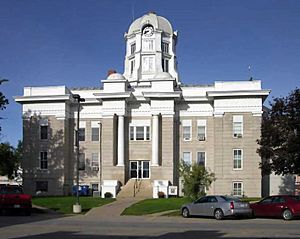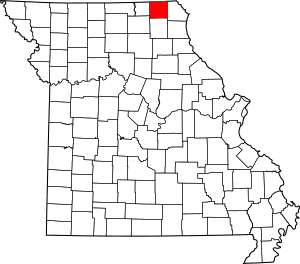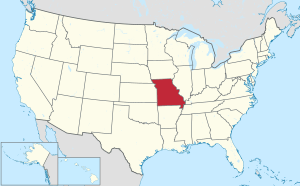Scotland County, Missouri facts for kids
Quick facts for kids
Scotland County
|
|
|---|---|

Scotland County court house in Memphis
|
|

Location within the U.S. state of Missouri
|
|
 Missouri's location within the U.S. |
|
| Country | |
| State | |
| Founded | January 29, 1841 |
| Named for | Scotland |
| Seat | Memphis |
| Largest city | Memphis |
| Area | |
| • Total | 439 sq mi (1,140 km2) |
| • Land | 437 sq mi (1,130 km2) |
| • Water | 2.6 sq mi (7 km2) 0.6% |
| Population
(2020)
|
|
| • Total | 4,716 |
| • Density | 10.743/sq mi (4.148/km2) |
| Time zone | UTC−6 (Central) |
| • Summer (DST) | UTC−5 (CDT) |
| Congressional district | 6th |
Scotland County is a county located in the northeastern part of Missouri. In 2020, about 4,716 people lived there. This makes it one of Missouri's counties with fewer people. The main town and county seat is Memphis. The county was officially started on January 29, 1841. It was named after the country of Scotland.
Contents
History of Scotland County
The Missouri General Assembly (which is like the state's government meeting) created Scotland County on January 29, 1841. At first, it included land that is now Knox County. But in 1843, that land became its own county. A person named Stephen W. B. Carnegy suggested naming the county after his home country, Scotland. He also gave Scottish names to some towns nearby.
The first European-American families settled in Scotland County in 1833. Brothers Levi and George Rhodes and their families settled near a place called Sand Hill. This area was in the southern part of the county, about 12 miles from where Memphis is today. A general store opened there around 1835. James I. Jones, who owned the store, also became Scotland County's first sheriff.
From its early days, some people in Scotland County owned slaves. This was less common here than in other parts of Missouri. In 1850, there were 157 enslaved people in the county. By 1860, this number had gone down to 131.
Farming was the most important way people made a living in Scotland County from the very beginning. After people cleared the forests and plowed the tough prairie grass, they found rich soil. Between 1850 and 1880, the number of farms grew a lot, from 334 to 1,994. The land itself was worth a lot of money. Corn was the main crop grown, followed by oats, wheat, and potatoes.
Scotland County and the Civil War
Scotland County saw three important battles during the American Civil War. The first battle happened in Etna on July 21, 1861. Union soldiers, called the 1st Northeast Missouri Home Guards, along with troops from Iowa and Illinois, attacked pro-Confederate forces. These Confederate forces were using Etna as a place to train and get supplies. The Union wanted to clear out Confederate supporters from rural Missouri. After a short fight, the Confederate forces, who were mostly cavalry (soldiers on horseback), were pushed out of Etna and the surrounding areas. The Union troops then went back to their base.
On July 13, 1862, Confederate Colonel Joseph C. Porter and his men entered Memphis. They captured the town with little fighting. They took weapons and supplies from the federal armory. The Confederates gathered all the adult men in town. They took them to the courthouse and made them promise not to tell anyone about the raiders for 48 hours.
Another important event happened in Memphis that day. Colonel Porter's men captured Dr. Wm. Aylward, a strong supporter of the Union. Later, guards claimed Dr. Aylward escaped. However, a Union supporter who asked Porter about Aylward was told, "He is where he will never disturb anybody else."
The next battle in the county took place on July 18, 1862. Union Colonel John McNeil had been chasing Porter's Confederate forces. When he heard Memphis was captured, McNeil sent about 300 Union soldiers to help. Porter and his Confederate forces planned to surprise the Union soldiers. This battle is known by different names, including the Battle of Vassar Hill or Oak Ridge. It happened about ten miles southwest of Memphis.
Porter's men hid in the bushes and waited until the Union soldiers were very close before firing. This made their shots more effective. The Union soldiers charged many times but did not gain much. More Union soldiers arrived, but eventually, the Union troops pulled back. Porter's forces stayed in control of the area until they left. The Union side had about 24 soldiers killed and 59 wounded. The Confederate side had fewer losses, with about three to six killed and some wounded.
Geography of Scotland County
Scotland County covers about 439 square miles. Most of this is land (437 square miles), and a small part (2.6 square miles) is water. Scotland County is located right next to Iowa to the north.
Neighboring Counties
- Davis County, Iowa (northwest)
- Van Buren County, Iowa (northeast)
- Clark County (east)
- Knox County (south)
- Adair County (southwest)
- Schuyler County (west)
Main Roads
People of Scotland County
In 2020, the population of Scotland County was 4,716 people. Most people living in the county are White (96.2%). A small number of people are Black or African American, Native American, Asian, or Pacific Islander. About 2.7% of the population are from other backgrounds or mixed races. About 0.74% of the people are Hispanic or Latino.
In 2010, there were about 1,902 households in the county. About 32.4% of these households had children under 18 living with them. The average household had about 2.55 people. The average family had about 3.16 people.
The population is spread out by age. About 28.6% of people are under 18 years old. About 19% of people are 65 years or older. The average age in the county was 37 years old.
Education in Scotland County
Public Schools
- [Scotland County R-I School District] – Memphis
- Scotland County Elementary School (Grades Pre-Kindergarten to 6)
- Scotland County High School (Grades 7 to 12)
Public Libraries
- Scotland County Memorial Library
Towns and Communities
Cities
- Memphis (the main town)
- South Gorin
Villages
Other Communities
- Azen
- Bible Grove
- Brock
- Crawford
- Edinburg
- Energy
- Etna
- Hitt
- Kilwinning
- Middle Fabius
- Pleasant Retreat
- Prospect Grove
- Sand Hill
- Unity
Famous People from Scotland County
- Ella Ewing, known as the world's tallest woman during her time. She lived much of her life near Gorin.
- Alexandre Hogue, a painter known for his realistic landscapes.
- Tom Horn, a famous person from the Old West who was a lawman, scout, and outlaw. He was born near Granger in 1860.
- George Saling, who won a gold medal at the 1932 Summer Olympics in the 110-meter hurdles race.
- Adrienne Wilkinson, an actress known for her roles in TV shows like Xena: Warrior Princess.
- Sedona Schnebly, a pioneer in Arizona and the person for whom Sedona, Arizona is named. She was born in Gorin.
See also
 In Spanish: Condado de Scotland (Misuri) para niños
In Spanish: Condado de Scotland (Misuri) para niños


